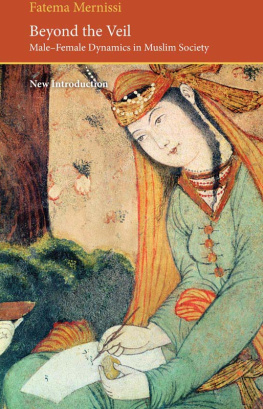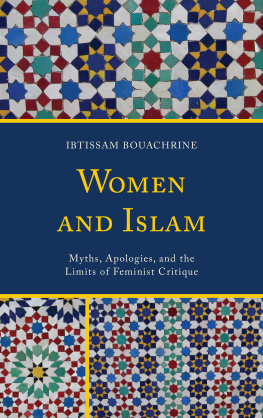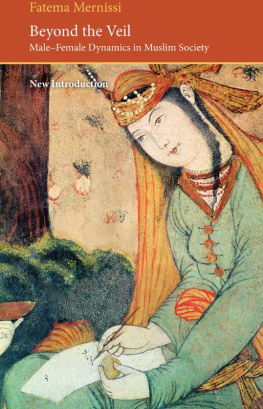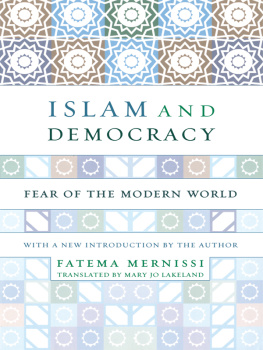Fatema Mernissi
Beyond the Veil
MaleFemale Dynamics in Muslim Society
EBOOK ISBN: 978-0-86356-479-6
First published by Schenkman Publishing Company, Inc., Cambridge,
Massachusetts, in 1975
First Saqi Books edition in 1985
This new ebook edition published 2011 by Saqi Books
Copyright Fatema Mernissi, 1975 and 2011
All rights reserved. No part of this book may be reproduced or transmitted in any form or by any means, electronic or mechanical, including photocopying, recording or by any information storage and retrieval system, without permission in writing from the publisher.
This book is sold subject to the condition that it shall not, by way of trade or otherwise, be lent, re-sold, hired out, or otherwise circulated without the publishers prior consent in any form of binding or cover other than that in which it is published and without a similar condition including this condition being imposed on the subsequent purchaser.
A full CIP record for this book is available from the British Library
A full CIP record for this book is available from the Library of Congress
SAQI
26 Westbourne Grove, London w2 5RH
www.saqibooks.com
Contents
NEW INTRODUCTION
Why Does the Veil Scare Europe?
The Female Body as the Sacred Community Link that Defies Consumerism
What is the event, unimaginable thirty years ago, that is worth mentioning in my new introduction to the reprint of Beyond the Veil, my Ph.D dissertation published in 1975? I quietly introduced this question in my seemingly aimless conversations with my old friend and colleague, Kamal, during one of our long weekend walks on the enchanting beaches of Casablanca. Kamal always complains that I use our beach walks to force him to think hard instead of relaxing. And he was right again, because after our conversation, I realised that the unimaginable event thirty years ago was that the veil has become a fixation of our twenty-first-century, secular, Western man.
To use France as an example, one of the obsessions of Mr Sarkozy, the president of France, and his cabinet ministers, who repeat constantly that their governments job is to defend laicit (preventing religion from invading public space) is to debate the Muslim veil question. But there is a contradiction in this, in that by debating the veil one is immersing oneself in the essence of what religion is about: the need to control narcissistic, pleasure-focused, sexual individualism. So, by insisting on debating the veil non-stop, Mr Sarkozy and his government have introduced religion into the public space that they were supposed to protect. How else can we explain this schizophrenic contradiction?
I would like to suggest that the sudden and obsessive twenty-first-century debates among European heads of state, governments and
In his book Orgasm and the West: A History of Pleasure from the Sixteenth Century to the Present, Robert Muchembled asked on , what is pleasure and what purpose does it serve?, and concluded on page 257 that the markets narcissistic focus on self-gratification forces people to swallow Viagra instead of thinking about reproducing themselves:
Never have the people of the West been so powerfully oriented and determined by their group as at the beginning of the twenty-first century. Individualism appears to triumph, but individuals are doomed by the laws of the economic market and the tyranny of the orgasm to become athletes in personal success, constantly required to demonstrate to others that they can do even better.
We therefore need to go back to focusing on why the Muslim veil was introduced in the seventh century.
The Purpose of the Seventh-Century Muslim Veil: Narcissistic Individualism Destroys Community Building
As I explained in the first part of my book, The Muslim Concept of Active Female Sexuality, quoting Imam Bukhari, in pre-Islamic Mecca, indiscriminate group sex was practiced by many, and women His long, polite silence revealed his total lack of interest, which is why Islam limited womens right to initiate any kind of marriage contract by bringing in a wali (guardian) from her family.

Matriarchy was the rule for the powerless tribes unable to defend their women and most children had no identifiable genetic father, thus belonging to the mothers tribe. Islam stopped narcissistic, pleasure-focused individualism, to focus instead on reproduction by limiting the female body to one single partner to give him a chance to become a father. Handsome men were forced to veil their beauty under a protective, mask-like, heavy turban (al-mutaamimun) to avoid being pursued by women in Mecca, explained Habib al-Baghdadi in a section entitled The Men who had to Use Turbans as Veils for Fear of Being Attacked by Women because of their Beauty!
The Prophet defined this pre-Islamic period as Jahiliya (which literally means barbarism), where unbridled, narcissistic, sexual
The genius of Islam is that it acknowledges that men are the weak partners who cannot resist womens charms, explained Imam Ibn Qayyim al-Jawziya in his thirteenth-century book, Garden of Lovers. Meditating on the Koran verse, He [God] created the human being weak And this brings me to confess that one thing I could not imagine thirty years ago was the emergence of sexually aggressive Muslim women, who flag the veil as a symbol of the need to control desire, in the Digital Islam Galaxy.
The First Veil Law in the East was that of Hammurabis in 1790 BC
The Eastern males obsession with the veiling of womens bodies as a way to put a certain limit on the unbridled desire to consume in general, and sex in particular did not start with Islam. Hammurabi, who ruled Babylon, a city not far from modern Baghdad from 1796 to 1750 BC, imposed the veil for aristocratic women and forbade prostitutes from using it in his famous code. Dated to 1790 BC, the Hammurabi Code regulates sexual consumerism by dividing the female population into consumable commodities and inaccessible goods: Neither wives of seigniors nor widows nor Assyrian women who go out on the street may have their heads uncovered. The daughters of a seignor ... must veil themselves ... when they go out on the street alone ... A sacred prostitute whom a man married must veil herself on the street, but one whom a man did not marry must have her head uncovered on the street; she must not veil herself. A harlot must not veil herself, her head must be uncovered ... He who has seen a harlot veil must arrest her ...













